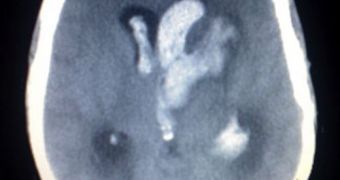According to a new scientific investigation, it would appear that zapping the brain with electricity is efficient in reducing the severity of symptoms associated with strokes, such as losing motor skills in arms, hands and legs.
By applying the new method, researchers say that these effects can be mitigated, at least to some extent. The solution is not a silver bullet for people who've had a stroke, but it can contribute to improving their quality of life.
The technique is not invasive, and it relies on applying electric stimulation to particular areas of the brain via electrodes placed on either sides of the head, explain researchers from the Beth Israel Deaconess Medical Center (BIDMC), who developed the therapy.
The team dubbed the approach bihemispheric transcranial direct current stimulation (tDCS). They report that, when used in combination with other therapies, it can lead to a 300 percent faster improvement rate in people who lost some of their motor functions in one or more limbs.
In a research paper appearing in the November 10 online issue of the esteemed scientific journal Neurology, the group details how it applied tDCS and a special regimen of physical and occupational therapy to patients. The experts say that they also managed to account for any other influencing factors.
In addition to the study group, a number of test participants only received physical and occupational rehabilitation, whereas members of another study group got just the placebo form of tDCS, Science Blog reports.
“We think that the key to this therapy’s success in improving stroke patients’ motor function is based on its ability to affect the brain activity on both the stroke-affected side of the brain and the healthy side of the brain as patients work to re-learn lost motor skills,” says Gottfried Schlaug, MD, PhD.
The scientist, who was the senior author of the Neurology paper , also holds an appointment as the Director of the Stroke Service in the BIDMC Department of Neurology. He is also an associate professor of neurology at the Harvard Medical School (HMS).
Researchers explain that, before strokes happen, the brains of normal people tend to function in a balanced manner, in the sense that both cortical hemisphere encourage and inhibit each other's actions. After stroke, the bridge that allows the hemispheres to communicate effectively can be damaged.
“As a result, the motor region on the unaffected side of the brain begins to exert an unbalanced effect onto the motor region of the brain’s damaged side,” explains BIDMC / HMS Instructor of Neurology and lead study author Robert Lindenberg,
“This is the first time that stimulation therapy has been administered simultaneously to both brain hemispheres and coupled with physical/occupational therapy,” Schlaug adds.
“Both sides of the brain play a role in recovery of function [following a stroke] and the combination of peripheral sensorimotor activities and central brain stimulation increases the brain’s ability to strengthen existing connections and form new connections,” he goes on to say.
“It is a testament of just how plastic the brain can be if novel and innovative therapies are applied using our current knowledge of brain function,” the expert concludes.

 14 DAY TRIAL //
14 DAY TRIAL //